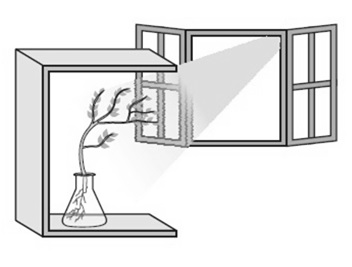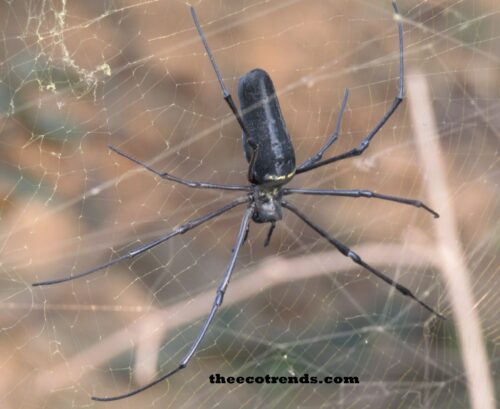Phototropism
The positive movements of a plant shoot in response to light or movement of shoot towards the source of light is called as Phototropism. If the part of a plant moves away from light, this movement is called as Negative Phototropism. The stem or the shoot of a plant shows positive phototropism where as the root system of a plant shows Negative Phototropism. Plants need sunlight as they have to synthesize food. This is the reason why leaves are spread in sun and the stems of plants grow towards light. Through experiments we can prove that plant stems bend towards sunlight. Many of us have clearly seen this event. But, how does it happen?
The bending of shoots towards sunlight is a response which occurs due to the action of the Phytohormones Auxins. When the source of light is in the side of the plant, the Auxins move away towards dark side. They initiate cell division in that side due to which the plant bends towards the source of light.
Phototropism is a survival tactics. It is through this tactics that plants can maximize their exposure to sunlight to make food. Charles Darwin performed many experiments in the late 1800s, and came to conclusion that photoreceptors or cells that detect light are found in the tips of plants. He observed that there must be some substance produced in the tip of the plant that is sent to lower part of the pant signaling it to bend.
Geotropism
Growth of parts of a plant in response to gravity is called as Geotropism. If part of a plant, say roots, grows towards the centre of the earth or towards the gravity, this type of growth movement is called as Positive Geotropism. The growth of shoot against gravity is called as Negative Geotropism. Geotropism is also called as Gravitropism. “Geo” means the “earth” and “tropos” means “to turn”. Thus turning of plant roots towards the earth or towards the centre of the earth is called as Geotropism or positive Geotropism.
The direction of the growth of root tips and stem tips in response to different stimuli including light and gravity is controlled by Auxins. Auxin is a group of plant hormones responsible for controlling the direction of growth of root tips and stem tips in response to different stimuli including light and gravity. Auxins change the elasticity of cells. More elastic cells absorb more water and grow longer, causing in the stem or root. It is reported that light and gravity can interfere with the transport of Auxins causing their uneven distribution.

Chemotropism
Response of parts of a plant to a chemical stimulus is called as Chemotropism. This may be positive or negative. If growth takes place towards the stimulus, it is called as Positive Geotropism whereas if growth takes place opposite to the direction of the stimulus, it is called as Negative Chemotropism. Example – growth of pollen tube down the style during fertilization in response to the presence of sugars in the style is an example of Positive Chemotropism.
Another example of positive and negative chemo-tropism is shown by a plant’s roots; the roots grow towards useful minerals displaying positive chemo-tropism, and grow away from harmful acids displaying negative chemo-tropism. Chemotropism is related to growth. It is different from Chemotaxis which is related to locomotion.
Hydrotropism
Tendency of roots to sense moisture and water and to grow towards these is called as Hydrotropism. A number of cases are routinely observed that show this tendency. It has been observed that if there is a source of water, say a river, a pond, or a well; roots of most of the trees move and grow in that direction.
Nastic Movements (Non-directional Response to stimuli)
Plant movement which occurs in response to environmental stimuli but unlike tropic movement, the direction of the response is not dependent on the direction of the stimulus is called as nastic movement. Example: Photonastic movement by Oxalis triangularis (leaves fold down at lower light levels. Key stimuli in these movements are temperature, humidity, irradiance etc. These movements can be due to changes in turgor or changes in growth. K+ ion concentration usually controls such movements in plants. Some of the nastic movements are mentioned below.
(i) Epinasty – the bending of an organ, such as petioles, leaves, and peduncles, toward the ground not due to gravity. The bending response is due to higher rate of longitudinal growth at the upper than at the lower side of the organ.
(ii) Hyponasty – the upward bending of an organ (reverse of epinasty).
(iii) Hydronasty – plant movement (for example the opening and closing of some flowers) in response to atmospheric humidity.
(iv) Nyctinasty – the sleep movement (opening and closing) of plant organs, such as leaves and flowers, due to day and night periods of daily rhythm. The leaves of many nyctinastic plants open during the day or part of the day and close at night. Nyctinastic movement caused by change in light intensity is called photonastic while that caused by change in temperature is called thermonastic.
(v) Seismonasty – movement in plants in response to touch as well as other forms of physical contact or mechanical disturbance such as shaking, wounding, wind, raindrops, and intense heat or burning. In the case of the sensitive plant (Mimosa pudica), a leaflet, leaf, or group of leaves rapidly folds and bends in response to the external stimulus.
The leaflets are arranged in opposite manner. When the plant is stimulated by touch or shock, the leaflets fold upwards and the main petiole droops. The mechanism of movement is based on changes in the turgor in swollen leaf bases particularly seen in leguminous plants. In the swollen leaf bases, it is the cells of the upper side that lose water, allowing the leaflets to move upwards. When the leaves of a sensitive plant having swollen leaf bases are touched, an electric impulse is generated which travels through ordinary cells as plants don’t have nerves and goes to the swollen petiole where it acts on a plant hormone. The plant hormone makes the water migrate from cells of one half of the swollen base. Due to this the swollen base loses its firmness making leaves to fold. After a few minutes the process is reversed when the stimulus goes away. The drooping of leaves of plants like that of Mimosa pudica is also referred as Thigmonasty.

(vi)Thigmonasty or haptonasty – plant movement in response to touch or physical contact without regard to the direction of the stimulus. Thigmonastic movements are exemplified by the closing of the insect-eating plant Venus’s flytrap (Dionaea muscipula) and the bending of the glandular hairs of sundew (Drosera sp.) as a result of contact with an insect.
Images NCERT




